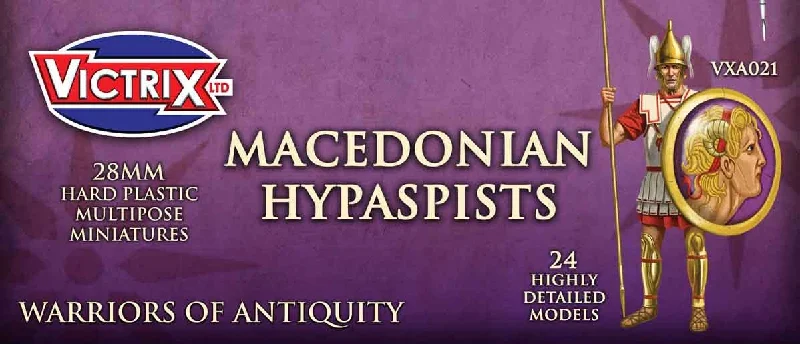- Warriors Of Antiquity
- 28mm scale
- 24 Highly detailed plastic figures, multiple pose options.
- 21 x Hypaspists
- 3 x Command
- 6 x Body options
- 13 x Head options
- 21 x spears
- 1 x Sword
- 1 x Trumpet
- 1 x Banner stand
- 25 x Shields
- 8 frames
- Molded in gray.
- Plastic packaging dimensions: 9.0” W x 13.5” H x 1.5” D
- Unpainted figures, assembly with glue and painting required.
This exceptional 24 figure set of 28mm hard plastic Macedonian Hypaspists has superbly detailed figures and a myriad of additional parts allowing hundreds of options when building the figures.
This unit, known as the Hypaspistai, or hypaspists, was probably armed like hoplites rather than as phalangites (pikemen) in Philip's Macedonian army. In battle, they were probably armed with the Greek aspis shield, spolas or linothorax body-armor, Hoplite's helmet, greaves, dory spear and a xiphos or kopis sword (though their equipment was likely more ornate than main-line soldiers). In set piece battles, the Macedonian Hypaspists were positioned on the flanks of the phalangite's phalanx; in turn, their own flanks were protected by light infantry and cavalry. Their job was to guard the flanks of the large and unwieldy pike phalanx. The armored Phalangites with their 18–22 ft. sarissas were not particularly agile or able to turn quickly, so hypaspists would prevent attacks on the vulnerable sides of the formation. Their role was vital to the success of Philip's tactics because the Macedonian phalanx was all but invulnerable from the front, and was, with five layers of iron spikes moving in unison, used as the anvil in a hammer and anvil tactic, where the Companion cavalry was the hammer that smashed the enemy against an anvil of thousands of iron spikes. As such an important yet vulnerable part of the Macedonian Army, it needed protection for its main vulnerability, the flanks. The protection/remedy for this vulnerability was the Hypaspists, who were able to conduct maneuvers and use tactics, which, owing to their hoplite panoply of weapons and armor, would have been impossible (or at least much less effective) if performed by the Phalangites.

